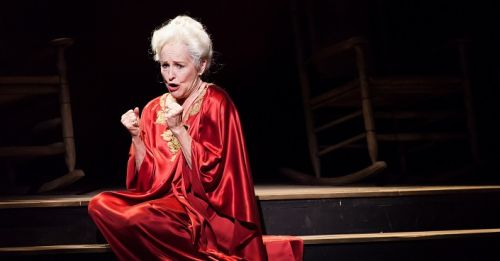 United States Gordon, A Coffin in Egypt: Kathleen Kelly (conductor), Wallis Annenberg Center for the Performing Arts, Beverly Hills, 23.4.14-27.4.14 (JRo)
United States Gordon, A Coffin in Egypt: Kathleen Kelly (conductor), Wallis Annenberg Center for the Performing Arts, Beverly Hills, 23.4.14-27.4.14 (JRo)

Photo by Lynn Lane.
Frederica von Stade had and always will have the ability to light up the stage with her incandescent presence and expressive voice. With her performance in A Coffin in Egypt at the Wallis Annenberg Center on Wednesday evening, nothing, in that regard, has changed. What has altered is the level of the vehicle for her talents. A chamber opera for five voices and four non-singing roles, A Coffin in Egypt never comes together as a unified whole, and its weaknesses tend to leave von Stade valiantly trying to breathe life into this ultimately unsatisfying work.
Ms. von Stade plays the role of Myrtle Bledsoe, the tragic ninety-year-old widow of Horton Foote’s play. Reminiscing and recriminating, fantasizing and agonizing over her marriage to the heartless Hunter Bledsoe, she lays out before us her troubled past in Egypt, Texas and during her periodic escapes abroad. Elegant in a floor length red caftan, von Stade sings solo for most of this eighty-minute piece. There is more vibrato to her golden voice – one of the finest of her day – but her expressiveness is undiminished. Unfortunately, one wishes for more nuance in the vocal scoring by Ricky Ian Gordon to allow us to hear some of the subtlety and humanity that Ms. von Stade brought to her most famous roles, notably Cherubino, Idamante, Rosina, and Cenerentola, to name a few.
Problems arise from the start because the production, with libretto and direction by Leonard Foglia, feels unformed: this is neither a one-woman show, nor a true ensemble piece. Von Stade is never given the opportunity to sing with her fellow performers. The four-person gospel chorus (admirably performed by Cheryl D. Clansy, Laura Elizabeth Patterson, James M. Winslow, and Jawan CM Jenkins) periodically chimes in with pleasant yet tepid musical commentary; but never do they sing or interact with Ms. von Stade. The actors playing her husband and sister-in-law – a convincing David Matranga and Carolyn Johnson – are given dramatic moments with von Stade; but because they all communicate in spoken word rather than music, the exchanges seem tacked on rather than organic to the piece. Since von Stade has no arias with her leading man or her sister-in-law, the musical drama never achieves an organic, emotional intensity, but must be created by von Stade’s voice alone. Imagine Blanche singing of her past life, then having to “talk” to Stanley in their scenes together; or Scarlet singing about Tara only to revert to spoken word in her scenes with Rhett.
The simplicity of the staging is effective: a single column suggesting the architecture of a stately Texas home, and undulating panels that form a backdrop for projected cotton blooms. Though the panels are beautifully constructed and arranged, the cotton feels more like distracting wallpaper than the suggestion of nature outside.
With Kathleen Kelly sensitively conducting, the nine-person ensemble of musicians did credit to the score. Though the music never offers the pathos of Samuel Barber in his Knoxville: Summer of 1915, or the sweep of Aaron Copland, Gordon’s attempt to create a musical vocabulary of Americana succeeds best in the pit when scoring instruments without accompanying voice.
There are moments of beauty and poignancy during the evening: we come to understand that the widow cares more for maintaining her dignity in the eyes of others than permanently escaping from her faithless, murderous husband. And we feel the inability of the average woman to create her own destiny during the period of Myrtle’s youth.
In the final moments of the opera, with her daughters, husband, and sister-in-law all dead, Myrtle laments, “Who’s left to come to my funeral?” I felt a tug at my heart – an inkling of what this original material by Horton Foote might have supplied and perhaps still could.
Jane Rosenberg
